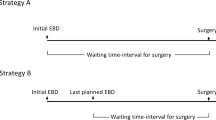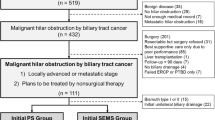Abstract
Purpose
Although endoscopic naso-biliary drainage (ENBD) is a popular preoperative biliary drainage (PBD) method for patients with perihilar biliary malignancy (PHBM), patient discomfort caused by the nasal tube remains a problem. This study aimed to analyze the safety and efficacy of PBD with the placement of a plastic stent above the papilla [inside-stent (IS)] as a bridging therapy.
Methods
The outcomes of 78 patients with potentially resectable PHBM, of whom 29 underwent IS placement and 49 underwent ENBD were evaluated.
Results
The stent-associated complication rates were not different between the two groups (7% in the IS group and 10% in the ENBD group, P = 0.621). Catheter dislocation occurred less frequently (0% vs. 22%, P = 0.016), and the median time to recurrent biliary obstruction was longer (not reached vs. 32 days, P = 0.039) in the IS group than in the ENBD group. Among the patients who underwent resection, their postoperative severe complication rates were not substantially different (26% vs. 25%, P = 0.923).
Conclusion
IS placement is a possible alternative to ENBD as a bridge to a definitive operation for patients with resectable PHBM and a prospective trial to prove its feasibility and safety is therefore warranted.



Similar content being viewed by others
References
Nimura Y, Hayakawa N, Kamiya J, Kondo S, Shionoya S. Hepatic segmentectomy with caudate lobe resection for bile duct carcinoma of the hepatic hilus. World J Surg. 1990;14(4):535–43 ((discussion 44)).
Yokoyama Y, Ebata T, Igami T, Sugawara G, Mizuno T, Nagino M. The adverse effects of preoperative cholangitis on the outcome of portal vein embolization and subsequent major hepatectomies. Surgery. 2014;156(5):1190–6.
Ribero D, Zimmitti G, Aloia TA, Shindoh J, Forchino F, Amisano M, et al. Preoperative cholangitis and future liver remnant volume determine the risk of liver failure in patients undergoing resection for hilar cholangiocarcinoma. J Am Coll Surg. 2016;223(1):87–97.
Sakata J, Shirai Y, Tsuchiya Y, Wakai T, Nomura T, Hatakeyama K. Preoperative cholangitis independently increases in-hospital mortality after combined major hepatic and bile duct resection for hilar cholangiocarcinoma. Langenbecks Arch Surg. 2009;394(6):1065–72.
Cho JY, Han H-S, Yoon Y-S, Hwang DW, Jung K, Kim JH, et al. Preoperative cholangitis and metastatic lymph node have a negative impact on survival after resection of extrahepatic bile duct cancer. World J Surg. 2012;36(8):1842–7.
Nagino M, Takada T, Miyazaki M, Miyakawa S, Tsukada K, Kondo S, et al. Preoperative biliary drainage for biliary tract and ampullary carcinomas. J Hepatobil Pancreat Surg. 2008;15(1):25–30.
Hameed A, Pang T, Chiou J, Pleass H, Lam V, Hollands M, et al. Percutaneous vs endoscopic pre-operative biliary drainage in hilar cholangiocarcinoma—a systematic review and meta-analysis. Hpb. 2016;18(5):400–10.
Nakai Y, Yamamoto R, Matsuyama M, Sakai Y, Takayama Y, Ushio J, et al. Multicenter study of endoscopic preoperative biliary drainage for malignant hilar biliary obstruction: E-POD hilar study. J Gastroenterol Hepatol. 2018;33(5):1146–53.
Takahashi Y, Ito H, Inoue Y, Mise Y, Ono Y, Sato T, et al. Preoperative biliary drainage for patients with perihilar bile duct malignancy. J Gastrointest Surg. 2020;24(7):1630–8.
Coelen RJS, Roos E, Wiggers JK, Besselink MG, Buis CI, Busch ORC, et al. Endoscopic versus percutaneous biliary drainage in patients with resectable perihilar cholangiocarcinoma: a multicentre, randomised controlled trial. Lancet Gastroenterol Hepatol. 2018;3(10):681–90.
Takahashi Y, Nagino M, Nishio H, Ebata T, Igami T, Nimura Y. Percutaneous transhepatic biliary drainage catheter tract recurrence in cholangiocarcinoma. Br J Surg. 2010;97(12):1860–6.
Komaya K, Ebata T, Yokoyama Y, Igami T, Sugawara G, Mizuno T, et al. Verification of the oncologic inferiority of percutaneous biliary drainage to endoscopic drainage: a propensity score matching analysis of resectable perihilar cholangiocarcinoma. Surgery. 2017;161(2):394–404.
Kawakami H, Kuwatani M, Onodera M, Haba S, Eto K, Ehira N, et al. Endoscopic nasobiliary drainage is the most suitable preoperative biliary drainage method in the management of patients with hilar cholangiocarcinoma. J Gastroenterol. 2010;46(2):242–8.
Kawakubo K, Kawakami H, Kuwatani M, Haba S, Kudo T, Taya YA, et al. Lower incidence of complications in endoscopic nasobiliary drainage for hilar cholangiocarcinoma. World J Gastrointest Endosc. 2016;8(9):385–90.
Kawashima H, Itoh A, Ohno E, Itoh Y, Ebata T, Nagino M, et al. Preoperative endoscopic nasobiliary drainage in 164 consecutive patients with suspected perihilar cholangiocarcinoma. Ann Surg. 2013;257(1):121–7.
Chaudhary RJ, Higuchi R, Nagino M, Unno M, Ohtsuka M, Endo I, et al. Survey of preoperative management protocol for perihilar cholangiocarcinoma at 10 Japanese high-volume centers with a combined experience of 2,778 cases. J Hepatobil Pancreat Sci. 2019;26(11):490–502.
Maeda T, Ebata T, Yokoyama Y, Mizuno T, Yamaguchi J, Onoe S, et al. Preoperative course of patients undergoing endoscopic nasobiliary drainage during the management of resectable perihilar cholangiocarcinoma. J Hepatobil Pancreat Sci. 2019;26(8):341–7.
Jo JH, Chung MJ, Han DH, Park JY, Bang S, Park SW, et al. Best options for preoperative biliary drainage in patients with Klatskin tumors. Surg Endosc. 2016;31(1):422–9.
Pedersen FM, Lassen AT, de Muckadell OBS. Randomized trial of stent placed above and across the sphincter of Oddi in malignant bile duct obstruction. Gastrointest Endosc. 1998;48(6):574–9.
Liu Q, Khay G, Cotton PB. Feasibility of stent placement above the sphincter of Oddi (“inside-stent”) for patients with malignant biliary obstruction. Endoscopy. 1998;30(8):687–90.
Yazumi S, Yoshimoto T, Hisatsune H, Hasegawa K, Kida M, Tada S, et al. Endoscopic treatment of biliary complications after right-lobe living-donor liver transplantation with duct-to-duct biliary anastomosis. J Hepatobil Pancreat Surg. 2006;13(6):502–10.
Tsujino T, Isayama H, Sugawara Y, Sasaki T, Kogure H, Nakai Y, et al. Endoscopic management of biliary complications after adult living donor liver transplantation. Am J Gastroenterol. 2006;101(10):2230–6.
Kurita A, Kodama Y, Minami R, Sakuma Y, Kuriyama K, Tanabe W, et al. Endoscopic stent placement above the intact sphincter of Oddi for biliary strictures after living donor liver transplantation. J Gastroenterol. 2013;48(9):1097–104.
Uchida N, Tsutsui K, Ezaki T, Fukuma H, Kamata H, Kobara H, et al. Estimation of the stent placement above the intact sphincter of Oddi against malignant bile duct obstruction. J Gastroenterol. 2005;40(3):291–6.
Ishiwatari H, Hayashi T, Ono M, Sato T, Kato J. Newly designed plastic stent for endoscopic placement above the sphincter of Oddi in patients with malignant hilar biliary obstruction. Dig Endosc. 2013;25(Suppl 2):94–9.
Inatomi O, Bamba S, Shioya M, Mochizuki Y, Ban H, Tsujikawa T, et al. Threaded biliary inside stents are a safe and effective therapeutic option in cases of malignant hilar obstruction. BMC Gastroenterol. 2013;13:31.
Kobayashi N, Watanabe S, Hosono K, Kubota K, Nakajima A, Kaneko T, et al. Endoscopic inside stent placement is suitable as a bridging treatment for preoperative biliary tract cancer. BMC Gastroenterol. 2015;15(8).
Kubota K, Hasegawa S, Iwasaki A, Sato T, Fujita Y, Hosono K, et al. Stent placement above the sphincter of Oddi permits implementation of neoadjuvant chemotherapy in patients with initially unresectable Klatskin tumor. Endosc Int Open. 2016;04(04):E427–33.
Isayama H, Hamada T, Yasuda I, Itoi T, Ryozawa S, Nakai Y, et al. TOKYO criteria 2014 for transpapillary biliary stenting. Dig Endosc. 2015;27(2):259–64.
Cotton PB, Lehman G, Vennes J, Geenen JE, Russell RC, Meyers WC, et al. Endoscopic sphincterotomy complications and their management: an attempt at consensus. Gastrointest Endosc. 1991;37(3):383–93.
Horan TC, Gaynes RP, Martone WJ, Jarvis WR, Emori TG. CDC definitions of nosocomial surgical site infections, 1992: a modification of CDC definitions of surgical wound infections. Infect Control Hosp Epidemiol. 1992;13(10):606–8.
Mangram AJ, Horan TC, Pearson ML, Silver LC, Jarvis WR. Guideline for prevention of surgical site infection, 2019. Hospital Infection Control Practices Advisory Committee. Infect Control Hosp Epidemiol. 1999;20(4):250–78 ((quiz 79–80)).
Dindo D, Demartines N, Clavien P-A. Classification of surgical complications. Ann Surg. 2004;240(2):205–13.
Mise Y, Vauthey J-N, Zimmitti G, Parker NH, Conrad C, Aloia TA, et al. Ninety-day postoperative mortality is a legitimate measure of hepatopancreatobiliary surgical quality. Ann Surg. 2015;262(6):1071–8.
Wiggers J, Koerkamp B, Coelen R, Rauws E, Schattner M, Nio C, et al. Preoperative biliary drainage in perihilar cholangiocarcinoma: identifying patients who require percutaneous drainage after failed endoscopic drainage. Endoscopy. 2015;47(12):1124–31.
Author information
Authors and Affiliations
Corresponding author
Ethics declarations
Conflict of interest
The authors declare no conflicts of interest.
Additional information
Publisher's Note
Springer Nature remains neutral with regard to jurisdictional claims in published maps and institutional affiliations.
Rights and permissions
About this article
Cite this article
Takahashi, Y., Sasahira, N., Sasaki, T. et al. The role of stent placement above the papilla (inside-stent) as a bridging therapy for perihilar biliary malignancy: an initial experience. Surg Today 51, 1795–1804 (2021). https://doi.org/10.1007/s00595-021-02268-8
Received:
Accepted:
Published:
Issue Date:
DOI: https://doi.org/10.1007/s00595-021-02268-8




